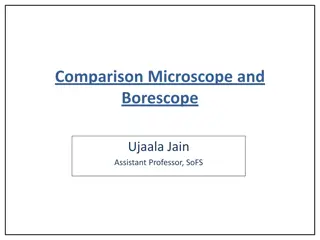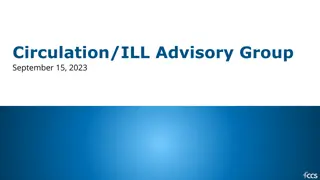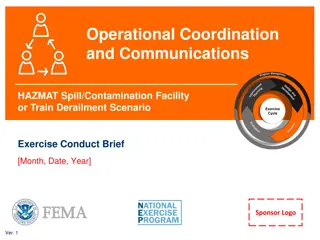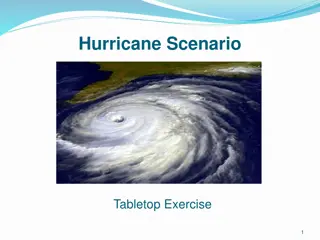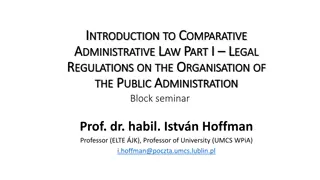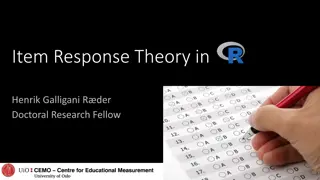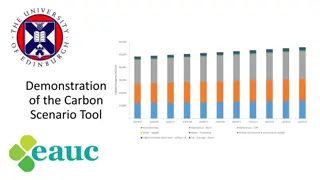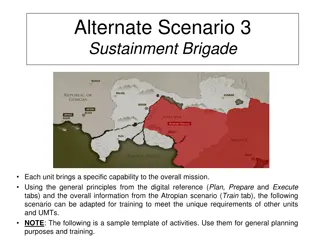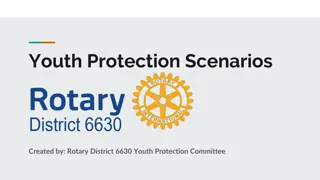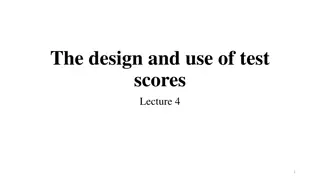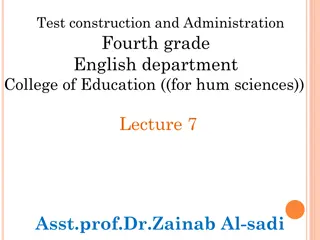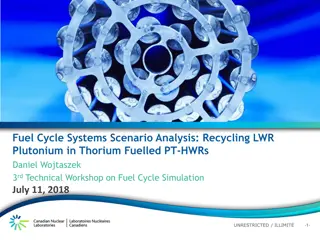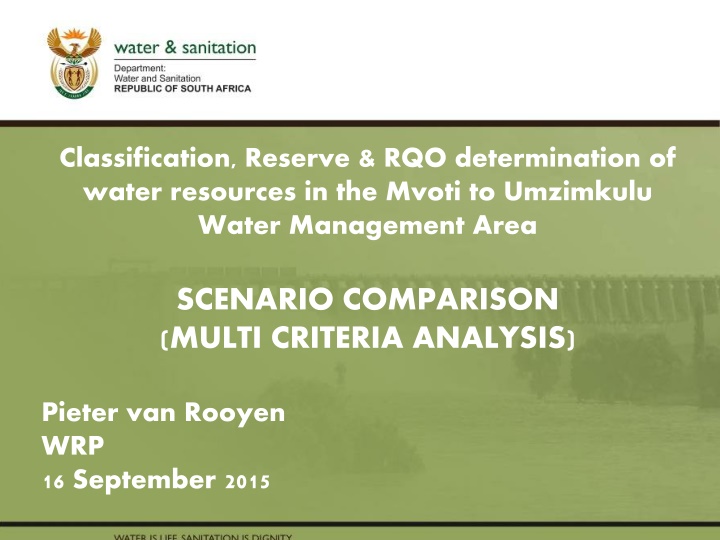
Water Resources Scenario Comparison in Mvoti to Umzimkulu Water Management Area
Explore the classification, reserve, and RQO determination of water resources in the Mvoti to Umzimkulu Water Management Area through a multi-criteria analysis. Discover the reasons for using MCA, application of model results, and detailed scenario definitions for ecological protection and cost-effective solutions.
Download Presentation

Please find below an Image/Link to download the presentation.
The content on the website is provided AS IS for your information and personal use only. It may not be sold, licensed, or shared on other websites without obtaining consent from the author. If you encounter any issues during the download, it is possible that the publisher has removed the file from their server.
You are allowed to download the files provided on this website for personal or commercial use, subject to the condition that they are used lawfully. All files are the property of their respective owners.
The content on the website is provided AS IS for your information and personal use only. It may not be sold, licensed, or shared on other websites without obtaining consent from the author.
E N D
Presentation Transcript
Classification, Reserve & RQO determination of PRESENTATION TITLE water resources in the Mvoti to Umzimkulu Water Management Area Presented by: Name Surname Directorate SCENARIO COMPARISON (MULTI CRITERIA ANALYSIS) Date Pieter van Rooyen WRP 16 September 2015
Layout of Presentation Estuary Scenarios: o Multi Criteria Analysis and scenario evaluation (recap) o Integrated assessment and overall ranking of scenarios. o Observations. o Covering the three estuary IUAs: Northern Cluster (iLlembe DM) Central Cluster (eThekwini MM) Southern Cluster (Ugu DM) uMngeni and Lovu Scenarios
Why Multi-Criteria Analysis? Method to compare alternatives where the outcomes (consequences) are in different numerical terms. Ecological consequences is a relative rating while economy is in monetary terms and employment in numbers. Multi-Criteria Analysis is appropriate in these circumstances.
Application of MCA model results The numerical ranking results from the MCA model serve as a guide for selecting the most appropriate scenario, configuration of Ecological Categories at nodes and the Water Resource Class for an IUA. Other factors that are also considered: Timeframe of the interventions build into a scenario. Bridging periods while investigations planned and implemented. Auxiliary ecological risks. Urgency of developments.
Central Cluster (CC) 16 Estuaries eThekwini MM Northern Cluster(NC) 7 Estuaries iLlembe DM Southern Cluster (SC) 41 Estuaries Ugu DM
Discussion Scenario Definitions Scenario Description Comment Sc Ai Ecological protection is priority (minimum discharge to estuaries) N & S Clusters: 30% of future ww flow to estuary, remainder through marine outfall. Aii Ecological protection is priority (minimum discharge to estuaries) N & S Cluster: Discharge current capacity, remainder disposal through marine outfall. Bi Minimum costs scenario (highest flow into estuaries) Options for Central Cluster: Low nutrient discharge from (high costs) Biii Minimum costs scenario (highest flow through estuaries) As Bi: Current treatment (high) nutrient discharge (low costs). C Current and short term (5 year) flow discharged into river systems, remainder through marine outfall. N and S Clusters: Short term increases in discharges. Central Cluster: Short term increases in discharges with low nutrient discharge (high costs) Ci Current and short term (5 year) flow discharged into river systems, remainder through marine outfall. Northern and Southern Clusters: Short term increases in discharges. Central Cluster: As C: Current treatment (high) nutrient discharge (low costs) D Current and medium term (10 year) flow discharged into river systems, remainder through marine outfall. N and S Clusters: Medium term increases in discharges. Central Cluster: Low nutrient discharge (high costs) C Current and short term (5 year) flow discharged into river systems, remainder through marine outfall. Northern and Southern Clusters: Short term increases in discharges. Central Cluster: Short term increases in discharges with low nutrient discharge (high costs) E Indirect re-use (consider volume and practicalities) Remainder According to Scenario C. Northern and Southern Clusters: Reuse 50% if future ww flow. Central Cluster: Reuse via Hazelmere Dam. F Direct re-use (consider volume and practicalities) Remainder According to Scenario C. N and S Clusters: Reuse 50% if future ww flow. Central Cluster: High level of treatment (high costs), supply into distribution system.
Central Cluster: Variables Scores IUA: CC Ecological Status relative to REC Overall Ranking (Normalised Method) Economic Indicator Ecosystem Services Employment Biii Ai Ai E Di E F Ci Di Ci D C D C C E D Ci Ai Bi Di Biii Bi F Biii F Bi 1 2 3 4 5 6 1.0 0.5 2.0 3.0 1.0 0.1 2.0 3.0 1.0 0.3 2.0 3.0 1.0 2.0 3.0 1.0 2.0 3.0 0.1
Variable Weights Variables Weights 50% Ecology Ecological Status Ecosystem Services Economic Indicator Employment 0.5 0.1 50% Socio-Economic 0.3 0.1
Central Cluster: Integrated Score IUA: CC Ecological Status relative to REC Overall Ranking (Normalised Method) Economic Indicator Ecosystem Services Employment Biii Ai Ai Cluster of scenarios with equivalent rank E Di E F Ci Di Ci D C D C C E D Ci Ai Bi Di Biii Bi F Biii F Bi 1 2 3 4 5 6 1.0 0.5 2.0 3.0 1.0 0.1 2.0 3.0 1.0 0.3 2.0 3.0 1.0 2.0 3.0 1.0 2.0 3.0 0.1
Observations Scenario Ai implies removal of most waste water, although it is the best scenario, it is an extreme scenario. Will be disruptive to implement over the short term. Both Scenario F (indirect reuse) and Scenario E (indirect reuse) achieve similar ecological health results. Sc F however has much higher cost implications than Scenario F. Compare scenarios without F and Ai.
Central Cluster: Variables Scores (excluding Ai and F) IUA: CC Ecological Status relative to REC Overall Ranking (Normalised Method) Economic Indicator Ecosystem Services Employment Biii E E Ci Di C D C D Ci Di Di Ci Biii Bi D C E Biii Bi Bi 1 2 3 4 5 6 1.0 0.5 2.0 3.0 1.0 0.1 2.0 3.0 1.0 0.3 2.0 3.0 1.0 2.0 3.0 1.0 2.0 3.0 0.1
Central Cluster: Integrated Score (excluding Ai and F) IUA: CC Ecological Status relative to REC Overall Ranking (Normalised Method) Economic Indicator Ecosystem Services Employment Biii E E Ci Di C D C D Ci Di Di Ci Biii Bi D C E Biii Bi Bi 1 2 3 4 5 6 1.0 0.5 2.0 3.0 1.0 0.1 2.0 3.0 1.0 0.3 2.0 3.0 1.0 2.0 3.0 1.0 2.0 3.0 0.1
Observations Scenarios E, indirect reuse (via Hazelmere Dam) can be considered as a long term option. Scenarios D and C allow for development over the medium term. Scenario B is ranked the lowest due to low level of protection (ecology). Compare scenarios for Northern Estuaries together (uMdloti and uThongathi) Adopt Scenarios D, Di, C and Ci for selection further discussion, agenda Item 6.7.
uMdloti and uThongathi: Variables Scores IUA: Ethekwini_TU Ecological Status relative to REC Overall Ranking (Normalised Method) Economic Indicator Ecosystem Services Employment Di Biii E Ai F E Ci D E Ai C Ai Ci F C Di Bi D C Ci Biii D Di F Bi Biii Bi 1 2 3 4 5 6 1.0 0.5 2.0 3.0 1.0 0.1 2.0 3.0 1.0 0.3 2.0 3.0 1.0 2.0 3.0 1.0 2.0 3.0 0.1
IUA: Ethekwini_TU Ecological Status relative to REC Overall Ranking (Normalised Method) uMdloti and uThongathi: Integrated Score Economic Indicator Ecosystem Services Employment Di Biii E Ai F E Ci D E Ai C Ai Ci F C Di Bi D C Ci Biii D Di F IUA: CC Ecological Status relative to REC Bi Overall Ranking (Normalised Method) Biii Bi Economic Indicator Ecosystem Services Employment 1 2 3 4 5 6 1.0 0.5 2.0 3.0 1.0 0.1 2.0 3.0 1.0 0.3 2.0 3.0 1.0 2.0 3.0 1.0 2.0 3.0 0.1 Biii E E Central Cluster Integrated Score Ci Di C D C D Ci Di Di Ci Biii Bi D C E Biii Bi Bi 1 2 3 4 5 6 1.0 0.5 2.0 3.0 1.0 0.1 2.0 3.0 1.0 0.3 2.0 3.0 1.0 2.0 3.0 1.0 2.0 3.0 0.1
Observations Scenarios E, indirect reuse (via Hazelmere Dam) can be considered as a long term option. All wastewater from uThonghati is reused (via Hazelmere Dam). All wastewater from uMdloti disposed through marine outfall for the scenario. Can improve scenario s ecological score by adding wastewater flow to uMdloti estuary. Therefore formulated a new scenario Gi (uMdloti).
uMdloti and uThongathi: Variables Scores IUA: Ethekwini_TU Ecological Status relative to REC Overall Ranking (Normalised Method) Economic Indicator Ecosystem Services Employment Di Biii Gi Gi E Ci DE Gi C Ai E F Ai Ai Ci Di C D F Bi C Biii Ci D Di F Bi Biii 3.0 Bi 1 2 3 4 5 6 1.0 0.5 2.0 1.0 0.1 2.0 3.0 1.0 0.3 2.0 3.0 1.0 2.0 3.0 1.0 2.0 3.0 0.1
uMdloti and uThongathi: Integrated Score (with Scenario Gi) IUA: Ethekwini_TU Ecological Status relative to REC Overall Ranking (Normalised Method) Economic Indicator Ecosystem Services Employment Di Biii Gi Gi E Ci DE Gi C Ai E F Ai Ai Ci Di C D F Bi C Biii Ci D Di F Bi Biii 3.0 Bi 1 2 3 4 5 6 1.0 0.5 2.0 1.0 0.1 2.0 3.0 1.0 0.3 2.0 3.0 1.0 2.0 3.0 1.0 2.0 3.0 0.1 Scenario Gi give best ranking, improvement to Scenario E.
Observations (uMdloti & uThonghati) Scenario Gi: All wastewater from uThonghati is reused (via Hazelmere Dam). Increase wastewater discharged into uMdloti estuary. Indirect re-use option could take many years to implement. Interim option to accommodate development pressure: Allow further discharge into uThonghati (Ecological health will reduce to an EC = E over medium term.) Design WWTW for expansion for indirect reuse. (Target Ecological Category over long term EC=C\D) Further discussion, agenda Item 6.7.
Summary for Central Cluster Scenarios D, Di, C and Ci to provide basis for further discussion for the Central Cluster in general, Scenario Gi to serve as guide for uMdloti & uThonghati. Further discussion part of agenda Item 6.7.
Northern Cluster: Variables Scores IUA: NC Ecological Status relative to REC Overall Ranking (Normalised Method) Economic Indicator Ecosystem Services Employment D D Ai Ai C Aii C E Aii E C D Bi Aii Ai Bi E Bi 1 2 3 4 5 6 1.0 0.5 2.0 3.0 1.0 0.1 2.0 3.0 1.0 0.3 2.0 3.0 1.0 2.0 3.0 1.0 2.0 3.0 0.1 Lables?
Northern Cluster: Integrated Score IUA: NC Ecological Status relative to REC Overall Ranking (Normalised Method) Economic Indicator Ecosystem Services Employment Flow into Estuaries (Ml/Day) Scenario D D D 20.9 Ai Ai C Aii C E Ai 6.1 Aii E C C 17.2 D Bi Aii Aii 17.8 E 19.8 Ai Bi E Bi 1 2 3 4 5 6 1.0 0.5 2.0 3.0 1.0 0.1 2.0 3.0 1.0 0.3 2.0 3.0 1.0 2.0 3.0 1.0 2.0 3.0 Bi 39.6 0.1 Lables?
Southern Cluster: Integrated Score IUA: SC Ecological Status relative to REC Overall Ranking (Normalised Method) Economic Indicator Ecosystem Services Employment Flow into Estuaries (Ml/Day) Scenario Aii C Bi C 22.8 D D Ai C C Ai D 24.9 D E Aii Ai 11.1 Aii Ai Aii 29.5 Bi E E 18.5 E Bi 1 2 3 4 5 6 1.0 0.5 2.0 3.0 1.0 0.1 2.0 3.0 1.0 0.3 2.0 3.0 1.0 2.0 3.0 1.0 2.0 3.0 Bi 37.0 0.1
Observations and Conclutions (Clusters SC & NC) Scenario Ai require expensive alternative wastewater disposal measures in the short term (discard). Scenario D and C, in general allow limited additional wastewater for increased developments. Further wastewater (over the long term) will have to be managed through alternative measures (prevent long term further discharges to estuaries.) Future wastewater management studies should include an assessment of the estuary ecology (will benefit from additional monitoring information ) Discussion of individual estuaries part of agenda Item 6.7.
Perspective (uMngeni River System) Current and planned system operating rules achieves ecological health objectives for the river EWR sites (flow related aspects). Operation of the system in the period shortly before further augmentation could result in a the system and ecological conditions being stressed for a few years. Full scale Multi-criteria Analysis was not required.
Perspective (Lovu River System) Scenarios to reduce abstraction was formulated to determine if estuary health can achieve the Recommended Ecological Category. Even with 50% reduction in abstraction (Scenario LO4) the REC for the estuary is not achieved. Scenario LO4 will have large negative economic implications. Full scale Multi-criteria Analysis was not required. Further discussion as part of Item 6.7


